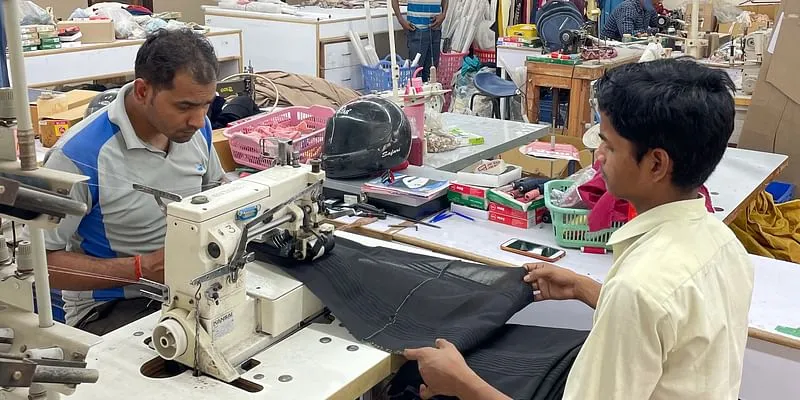How this brother duo bounced back from failure to build an apparel business serving more than 75,000 customers a month
Noida-based apparel brand Lakshita was started in 2002 by brother duo Sachin and Suneet Kharbanda. The brand, which manufactures and sells fusion wear, has especially, carved a niche in the north Indian market.
Two brothers, Sachin and Suneet Kharbanda, got into the business of exports right after completing their education in 1995. They started manufacturing and exporting women’s wear to the US, and even sold the apparel in the domestic market.
They continued for about three years but things never seemed to work out. Sachin explains to SMBStory, “We were only concentrating on manufacturing and making samples. Additionally, we were having conversations with wholesalers or retailers, and not the final consumer. This was leading to a gap.”
Sachin says that both the brothers were always in the factory, trying to improve the existing items, but didn’t really know what was selling in the market. Their businesses reached a dead end and they had to shut shop.
However, this was only the beginning of another eventful journey.
Sachin says that while selling was their weakness, manufacturing became their strength. The brothers converted a property in Noida’s Sector-18 market into a factory outlet in 2002, and started selling women’s shirts and tunics.
This outlet helped them directly interact with customers, and their feedback helped them understand the market better and deliver according to the ongoing trends.
This is how fusion wear brand came into existence.
From one store, Lakshita grew to 69 stores (in the pre-pandemic era) and has become a well-known retail apparel brand in north India.

Catering to the mature women clothing category
Reminiscing on his initial days, Sachin says that the first few years were about meeting the customer demand by aligning their supply chains and procurement processes.
When more people started visiting the outlet, they got the confidence to expand. In the next three years, they opened 10 more outlets in and around Noida and Delhi.
The biggest learning that came from interacting with customers was that women were looking for something casual yet traditional. Sachin explains, “A lot of brands were either offering sarees or suits, which were on the heavier side (in terms of design).”
The factory outlet was surrounded by shops that were focused on modern wear with western influence. Due to the growing MNC culture in Noida, women looked for brands that were offering something that could be worn every day, and at the same time, stuck to the roots.
This is the market that Lakshita tried to cover. Sachin calls this category the “mature women clothing.” “We introduced designs that are fun, contemporary, and yet casual. We are a fusion brand that is focused on Indo-western elements,” he adds.
He explains that Lakshita’s designs have a 25 percent western influence, and the rest is traditional – keeping in mind the Indian sensibilities. Sachin also adds that they ensured there was no heavy embroidery on the kurtis or tops, and also introduced women’s business suits and coats, which were well-received.
All clothes are manufactured at Lakshita’s unit in Noida. The raw materials are sourced from around India, as well as imported from Japan, South Korea, and Italy.
Lakshita manufactures 3,000 garments a day and claims to serve between 75,000-1 lakh customers in a month. The average ticket size of the items is less than Rs 2,000.

Sachin Kharbanda, CEO, Lakshita Fashions Pvt Ltd.
Evolution of the industry
Sachin says that the ecosystem has transformed tremendously. According to a report by McKinsey and Company, the Indian apparel market is expected to become worth $59.3 billion in 2022, making it the sixth-largest in the world – comparable to the United Kingdom ($65 billion) and Germany ($63.1 billion). India houses numerous brands including , , Wills, , Melange, Aurelia, etc. Sachin says that over the years, competition has increased enormously, especially with the entry of several international players like H&M, Zara, etc.
He also highlights that ecommerce has further made it difficult to survive in the market. “Back when we started, retailers were in a luxury mood. There were also times when shopkeepers would close their shops in the afternoon and break for lunch. Now, nobody can afford to do that.”
Sachin describes that the last 10 years have been very difficult. The internet economy compelled businesses to innovate and take the digital route. Lakshita, that would earlier see ecommerce as a distant competition, too realised the need to go digital. It launched its website a few years ago and Sachin says that “going online has really complimented the brand.”
Over the years, the brand has also diversified into other categories like dresses, bottomwear, dupattas, festival collection, tunics etc. The brand offers eight sizes – from small to 4X – to cater to people of all shapes and sizes. “We realised that many plus-sized had to get the outfit tailored as there were no particular shops that catered to them.”
Sachin terms the garment industry as very dynamic. He shares that, “Buying is emotional. A garment that is priced less doesn’t always sell.”
In the pre-pandemic era, Lakshita had 69 stores, mainly in north India, as well as in some parts of Maharashtra.
“Entire north India has the same taste. For example, a place like Delhi is more happening, so clothes with embroidery and work sell more as compared to a market like Maharashtra, where people prefer simpler clothes, he explains”
The brand is also present in Tier-II cities like Lucknow, Mohali, Karnal, Amritsar etc.
The COVID-19 impact and the road ahead
From 2002 to the present, the brand and the founders have faced numerous challenges. Talking about how the brand has managed to survive and stay relevant, Sachin says,
“Business means to face the challenges and we should always be ready to innovate.”
Sachin survived the coronavirus pandemic-led lockdown with this very mantra. Several outlets had to be closed down in the wake of last year’s events. The brand is currently operating 51 stores and is projecting a 30 percent cut in its turnover.
The pandemic, however, resulted in online sales shooting up by 3x.
“We are not an essential brand that sells T-shirts or nightwear. We are a fashion brand. Hence, we took a hit. Going forward, our focus will be on retaining our loyal customers,” he says.
Sachin also adds that the sales have started picking up since January 2021. “Retail will flourish when there is joy among people. Now, since the arrival of the vaccine, people have started going out and they can be seen indulging in retail therapy.”
The brand doesn’t want to explore the south Indian markets and wants to focus on becoming a 50 percent online brand in the next three years.
Sachin says that the stage is also set for the younger generation to take over. Sachin’s sons Kuber and Kabir Kharbanda and Suneet’s daughters Lavanya and Lakshita Kharbanda joined the business recently.
Edited by Kanishk Singh









